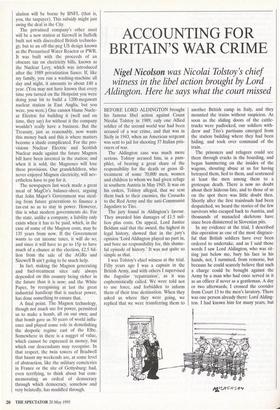IT SHOULD GO LIKE A BOMB
James Buchan discovers a curious consequence of the latest privatisation: the City will own a mass of weapons grade plutonium
THE CITY of London is about to be offered the unique opportunity to invest in one of the most curious products of cre- ation. It is a silvery metal, warm to the touch, that can be fabricated into all sorts of shapes. Wrapped up, it can be handled safely; but on no account should it be placed anywhere near the mouth.
Its commercial uses are as yet restricted. In minute quantities, it has powered heart pacemakers. In theory, it can be fabricated into a fuel to generate electric power, but at present it would be much more cost- effective to incinerate high-denomination bank-notes. But as bomb explosive it has no peer.
This element, which is known as plutoni- um, will — in evident breach of the nucle- ar non-proliferation treaty — become available to those City-investing institu- tions that buy stock in the British nuclear power generators, Nuclear Electric and Scottish Nuclear, which are to be sold next year. These companies operate 13 power stations that create plutonium as a by- product of their chain-reactions: for 43 years, it has been this country's practice to separate out this plutonium through chem- ical treatment of the spent fuel at Sell- afield in Cumbria. Just a few pounds of plutonium will obliterate a city. Fund man- agers, dozing through the warm dusk down to Haslemere and family, will perhaps dream convulsively of their own private Nagasakis.
In fairness to Nuclear Electric, its offi- cials did point out to the Government that this would be poor public relations and had the potential to detonate the sale; and if the Department of Trade and Industry didn't listen, well, nobody in central gov- ernment has ever had much of a flair for nuclear power. (Even at the Treasury, when I mentioned this point in passing last week, it was as if I'd put some weapons- grade plutonium on the table. One official dropped his pencil.) It is surely not beyond the wit of government to devise a mecha- nism whereby the state can hold the pluto- nium in trust at Sellafield — we already own 50 tons of the damn stuff — until such moment when it has some legal and com- mercial value to its owners. The plutonium issue merely shows that the Government, in its heroic effort to put an end to half a century of nuclear muddle, has a hard task ahead.
The DTI and Scottish Office White Paper, The Prospects for Nuclear Power in the UK, which was published on 9 May, is very clever. Those of us who have argued ourselves blue — or maybe it was just me — that no new nuclear station should be built in a glutted power market, that the nuclear tax electricity users pay is foolish and unfair, that the old Magnox power stations should be shut down in orderly fashion and everything that can be priva- tised should be, feel thoroughly vindicat- ed.
At Osea, a small island in the Blackwa- ter Estuary in Essex, where I spend my weekends, you can see the history of British nuclear power in an instant: here is where it was born, struggled for a while, and then fell into decline. Each time I drive over the brimming tidal causeway, or align my rowing-boat to find the channel between the saltings, two giant boxes . get off the M4 at the junction after that, turn left at the Asda five miles further on, then go on for two miles and the hospital is on the left' swing in and out of my view, troubling the flat horizon like the pyramids beside the upper Nile and, like them, monuments to a futile ingenuity.
These two reactors at Bradwell-on-Sea were built on a wartime air-base in the late 1950s at the immense cost, for those days, of £60 million: local old-timers still remem- ber the beer and oyster days of its construc- tion. Because its home-made technology had been designed to make a bomb, not electric power, it has never produced much by way of electricity; but it has produced an awful lot of plutonium and hazardous nuclear waste. 'The British Magnox pro- gramme,' Lord Marshall, once chairman of the old Central Electricity Generating Board, told the House of Commons in 1990, 'has probably produced more nuclear waste than all the rest of the world put together.' In a sense, Bradwell and the ten other Magnoxes were simply machines for generating liabilities: plutonium, which has to be stored and guarded at great expense at British Nuclear Fuels in Sellafield, thou- sands of tons of highly radioactive waste and badly contaminated sites. Since they lose money by any conventional accounting — £240 million for Nuclear Electric last year — it seems astonishing that Margaret Thatcher and Cecil Parkinson ever thought they could be sold for money.
According to last week's White Paper, a state company, currently nicknamed MagCo, will own the Magnoxes. It will have a balance-sheet from hell: liabilities with a 1995 value of £8.5 billion and no assets, but some cash and a letter from the Government saying that the faith and cred- it of the United Kingdom rest behind this ruined enterprise. Eventually, MagCo will be transferred to the state-owned British Nuclear Fuels, and for this reason: the chief costs of the Magnoxes arise not at the generating sites but at the fuel-treatment plants at Sellafield, where BNFL charges monopoly prices. Once it owns the Mag- noxes, BNFL will have no interest in high prices. It is a stroke of bureaucratic genius, though rather hard on poor BNFL which doesn't seem to have been asked whether it wanted to go into the electricity-generation business. In the House of Commons, Michael Heseltine then spoilt it all by sug- gesting that BNFL run the stations for as long as possible. It was an irresponsible statement which I'm sure BNFL will ignore. It would be better to shut down one every year from now on, ending up with the main treatment plant at Sellafield in, say, 2005.
What the City is being offered is quite a bit better, though it has a dismal history. In the summer of 1964, engineers of the Atomic Energy Authority decided that a tiny Advanced Gas-Cooled Reactor proto- type at Sellafield could be scaled up to a 660-megawatt station at Dungeness in Kent. This decision, among the most costly in all British industrial history, littered England and Scotland with AGR stations, many of which simply would not work. By last year, Nuclear Electric had managed to fix even the dog — Dungeness B — and the stations were running at 85 per cent of capacity, which is very good indeed. But things are going wrong again (at Dun- geness and at Heysham in Lancashire), and the City will have to decide whether these problems are generic to the AGR technology — as Greenpeace states, with- out any good evidence — or just to the sta- tions in question. For this reason, the privatised company (provisionally known as APCo) will probably seek to generate power by other fuels. Gas stations, which can be built quickly and easily switched on and off, are the obvious, if perverse, way out. The key point is that the AGRs will carry a government subsidy, for their fuel- treatment contracts at Sellafield are for fixed sums, so any increases in cost or reg- . ulation will be borne by BNFL (that is, you, the taxpayer). This subsidy might just swing the deal in the City.
The privatised company's other asset will be a new station at Sizewell in Suffolk built not with discredited British technolo- gy, but to an off-the-peg US design known as the Pressurised Water Reactor or PWR. It was built with the proceeds of an obscure tax on electricity bills, known as the Nuclear Levy, which was introduced after the 1989 privatisation fiasco. If, like my family, you run a washing-machine all day and night, it amounts to about £40 a year. (You may not have known that every time you turned on the Hotpoint you were doing your bit to build a 1200-megawatt nuclear station in East Anglia, but you were, you were.) One cannot blame Nucle- ar Electric for building it (well and on time, they say) for without it the company wouldn't really have a business. But the Treasury, just as reasonably, now wants this money back and this is where matters become a shade complicated. For the pro- visions Nuclear Electric and Scottish Nuclear made against the future Magnox bill have been invested in the station; and when it is sold, the Magnoxes will lose these provisions. Our grandchildren, who never enjoyed Magnox electricity, will nev- ertheless have to pay for it.
The newspapers last week made a great meal of MagCo's balance-sheet, arguing that John Major's Government was steal- ing from future generations to finance a tax-cut so as to stay in power. However, this is what modern governments do. For the state, unlike a company, a liability only exists when it has to be paid, which, in the case of some of the Magnox costs, may be 135 years from now. If the Government wants to cut income taxes, it will do so; and since it will have to go to 15p to have much of a chance at the election, £2.5 bil- lion from the sale of the AGRs and Sizewell B ain't going to be much help.
In fact, making the Magnox generating and fuel-treatment sites safe always depended on this country being richer in the future than it is now; and the White Paper, by recognising at last the great industrial handicap that is nuclear power, has done something to ensure that.
A final point. The Magnox technology, though not much use for power, permitted us to make a bomb, all on our own; and that bomb gave us 50 years of world influ- ence and played some role in demolishing the despotic regime east of the Elbe. Somewhere in there is a nugget of value, which cannot be expressed in money, but which our descendants may recognise. In that respect, the twin towers of Bradwell that haunt my weekends are, at some level of abstraction, like the military cemeteries in France or the site of Gettysburg: bad, even terrifying, to think about but com- memorating an ordeal of democracy through which democracy, somehow and very belatedly, has muddled through.




































































 Previous page
Previous page